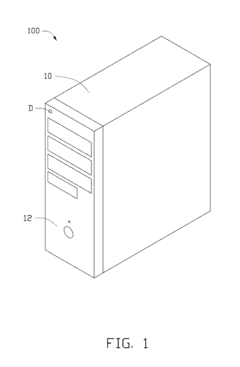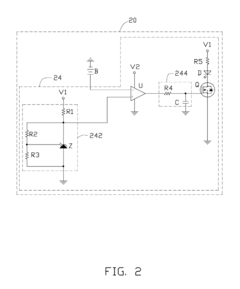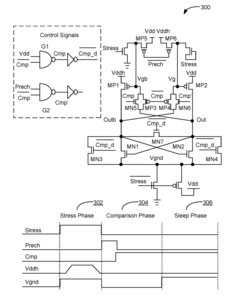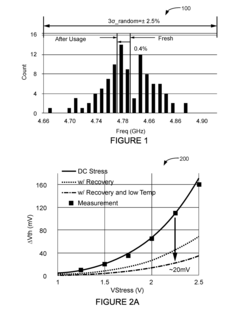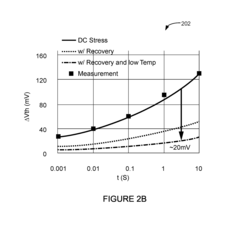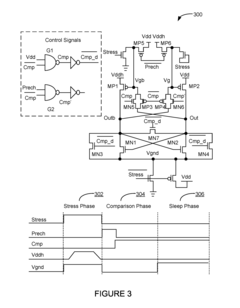How CMOS Battery Catalyzes Personalized User Experience Enhancements?
JUL 22, 20259 MIN READ
Generate Your Research Report Instantly with AI Agent
Patsnap Eureka helps you evaluate technical feasibility & market potential.
CMOS Battery Evolution
The evolution of CMOS battery technology has played a crucial role in shaping personalized user experiences in modern computing devices. Initially introduced in the 1980s as a simple power source for maintaining basic system settings, CMOS batteries have undergone significant transformations to meet the growing demands of increasingly sophisticated hardware and software ecosystems.
In the early stages of personal computing, CMOS batteries were primarily used to keep system clocks running and preserve BIOS settings when the main power was disconnected. This fundamental function ensured that users could maintain a consistent experience across power cycles, eliminating the need for manual reconfiguration each time a device was turned on.
As computing devices became more complex, the role of CMOS batteries expanded beyond timekeeping and BIOS preservation. They began to support a wider range of persistent settings, including hardware configurations, boot preferences, and security parameters. This evolution allowed for more personalized and efficient user experiences, as devices could retain individual preferences and optimizations even when powered down.
The advent of mobile computing in the late 1990s and early 2000s brought new challenges and opportunities for CMOS battery technology. Manufacturers had to balance the need for long-lasting power sources with the constraints of increasingly compact device designs. This led to innovations in battery chemistry and form factors, resulting in smaller, more efficient CMOS batteries that could support a broader range of functions without compromising device portability.
In recent years, the integration of CMOS batteries with advanced power management systems has further enhanced their role in personalizing user experiences. Modern devices can now leverage CMOS battery data to optimize power consumption based on individual usage patterns, extending battery life and improving overall system performance. This adaptive approach allows devices to tailor their behavior to each user's unique needs and preferences.
The evolution of CMOS batteries has also intersected with the development of cloud-based services and always-connected devices. While traditional CMOS functions are still critical, the ability to synchronize and backup settings across multiple devices has reduced reliance on local storage for some types of personalization data. However, CMOS batteries continue to play a vital role in maintaining core system integrity and providing a seamless user experience during offline periods or network disruptions.
Looking ahead, the ongoing miniaturization of electronic components and the rise of wearable and IoT devices present new frontiers for CMOS battery evolution. Future innovations may focus on even more energy-efficient designs, integration with energy harvesting technologies, and enhanced capabilities to support increasingly sophisticated personalization features across a diverse range of connected devices.
In the early stages of personal computing, CMOS batteries were primarily used to keep system clocks running and preserve BIOS settings when the main power was disconnected. This fundamental function ensured that users could maintain a consistent experience across power cycles, eliminating the need for manual reconfiguration each time a device was turned on.
As computing devices became more complex, the role of CMOS batteries expanded beyond timekeeping and BIOS preservation. They began to support a wider range of persistent settings, including hardware configurations, boot preferences, and security parameters. This evolution allowed for more personalized and efficient user experiences, as devices could retain individual preferences and optimizations even when powered down.
The advent of mobile computing in the late 1990s and early 2000s brought new challenges and opportunities for CMOS battery technology. Manufacturers had to balance the need for long-lasting power sources with the constraints of increasingly compact device designs. This led to innovations in battery chemistry and form factors, resulting in smaller, more efficient CMOS batteries that could support a broader range of functions without compromising device portability.
In recent years, the integration of CMOS batteries with advanced power management systems has further enhanced their role in personalizing user experiences. Modern devices can now leverage CMOS battery data to optimize power consumption based on individual usage patterns, extending battery life and improving overall system performance. This adaptive approach allows devices to tailor their behavior to each user's unique needs and preferences.
The evolution of CMOS batteries has also intersected with the development of cloud-based services and always-connected devices. While traditional CMOS functions are still critical, the ability to synchronize and backup settings across multiple devices has reduced reliance on local storage for some types of personalization data. However, CMOS batteries continue to play a vital role in maintaining core system integrity and providing a seamless user experience during offline periods or network disruptions.
Looking ahead, the ongoing miniaturization of electronic components and the rise of wearable and IoT devices present new frontiers for CMOS battery evolution. Future innovations may focus on even more energy-efficient designs, integration with energy harvesting technologies, and enhanced capabilities to support increasingly sophisticated personalization features across a diverse range of connected devices.
User Experience Market
The user experience market has witnessed significant growth and transformation in recent years, driven by the increasing importance of personalized digital interactions. As consumers become more tech-savvy and demanding, businesses across various sectors are prioritizing user experience (UX) as a key differentiator. The global UX market size was valued at $465 billion in 2021 and is projected to reach $1.3 trillion by 2028, growing at a CAGR of 16.2% during the forecast period.
The demand for personalized user experiences is particularly strong in e-commerce, healthcare, finance, and entertainment sectors. E-commerce platforms are leveraging AI and machine learning algorithms to provide tailored product recommendations, while healthcare providers are developing patient-centric digital interfaces to improve engagement and outcomes. Financial institutions are focusing on creating intuitive mobile banking apps and personalized financial advice tools, and streaming services are fine-tuning their content recommendation engines to keep users engaged.
The COVID-19 pandemic has accelerated the adoption of digital technologies, further fueling the growth of the UX market. Remote work, online education, and telemedicine have become mainstream, creating new opportunities for UX designers and developers to enhance digital experiences across these domains. This shift has also highlighted the importance of accessibility and inclusive design, as diverse user groups rely more heavily on digital interfaces for daily activities.
Emerging technologies such as augmented reality (AR), virtual reality (VR), and voice interfaces are reshaping the UX landscape. These technologies offer new ways to create immersive and intuitive user experiences, opening up possibilities for innovative applications in retail, education, and entertainment. The integration of these technologies with personalization algorithms is expected to drive the next wave of UX innovations.
The UX market is characterized by a mix of established tech giants and innovative startups. Companies like Adobe, Salesforce, and IBM offer comprehensive UX design and analytics tools, while startups are focusing on niche areas such as voice user interfaces and emotion recognition in UX. The competitive landscape is dynamic, with frequent mergers and acquisitions as larger companies seek to expand their UX capabilities.
As the UX market continues to evolve, several trends are shaping its future. These include the rise of zero UI and ambient computing, where interactions become more seamless and integrated into the environment; the growing importance of data privacy and ethical design in UX; and the increasing use of AI-driven personalization to create hyper-individualized experiences. The challenge for businesses will be to balance these advanced personalization capabilities with user privacy concerns and regulatory requirements.
The demand for personalized user experiences is particularly strong in e-commerce, healthcare, finance, and entertainment sectors. E-commerce platforms are leveraging AI and machine learning algorithms to provide tailored product recommendations, while healthcare providers are developing patient-centric digital interfaces to improve engagement and outcomes. Financial institutions are focusing on creating intuitive mobile banking apps and personalized financial advice tools, and streaming services are fine-tuning their content recommendation engines to keep users engaged.
The COVID-19 pandemic has accelerated the adoption of digital technologies, further fueling the growth of the UX market. Remote work, online education, and telemedicine have become mainstream, creating new opportunities for UX designers and developers to enhance digital experiences across these domains. This shift has also highlighted the importance of accessibility and inclusive design, as diverse user groups rely more heavily on digital interfaces for daily activities.
Emerging technologies such as augmented reality (AR), virtual reality (VR), and voice interfaces are reshaping the UX landscape. These technologies offer new ways to create immersive and intuitive user experiences, opening up possibilities for innovative applications in retail, education, and entertainment. The integration of these technologies with personalization algorithms is expected to drive the next wave of UX innovations.
The UX market is characterized by a mix of established tech giants and innovative startups. Companies like Adobe, Salesforce, and IBM offer comprehensive UX design and analytics tools, while startups are focusing on niche areas such as voice user interfaces and emotion recognition in UX. The competitive landscape is dynamic, with frequent mergers and acquisitions as larger companies seek to expand their UX capabilities.
As the UX market continues to evolve, several trends are shaping its future. These include the rise of zero UI and ambient computing, where interactions become more seamless and integrated into the environment; the growing importance of data privacy and ethical design in UX; and the increasing use of AI-driven personalization to create hyper-individualized experiences. The challenge for businesses will be to balance these advanced personalization capabilities with user privacy concerns and regulatory requirements.
CMOS Challenges
The CMOS battery, a critical component in modern computing systems, faces several challenges in its role of enhancing personalized user experiences. One of the primary issues is the limited lifespan of these batteries, typically ranging from 3 to 5 years. As devices become more sophisticated and users demand increasingly personalized experiences, the strain on CMOS batteries intensifies, potentially leading to more frequent replacements and system disruptions.
Another significant challenge lies in the power management of CMOS batteries. As they are responsible for maintaining system settings and real-time clock functions, even when the main power is off, there is a constant drain on these batteries. This continuous power draw can be exacerbated by advanced personalization features that require constant updates or memory retention, potentially shortening the battery's effective lifespan.
The size constraints of modern devices also pose a challenge for CMOS batteries. As consumer electronics and computing devices become smaller and more compact, there is increasing pressure to reduce the size of all components, including the CMOS battery. This miniaturization trend conflicts with the need for longer-lasting batteries to support enhanced personalization features, creating a design dilemma for manufacturers.
Environmental factors present another set of challenges for CMOS batteries. Extreme temperatures, humidity, and other environmental conditions can significantly impact battery performance and lifespan. This is particularly problematic for devices used in diverse settings or harsh environments, where maintaining consistent personalized user experiences becomes more difficult due to potential CMOS battery failures.
Security concerns also emerge as a challenge in the context of CMOS batteries and personalized user experiences. As these batteries store critical system information and user preferences, they become potential targets for malicious attacks. Ensuring the integrity and security of the data stored by CMOS batteries, while still allowing for seamless personalization, presents a complex challenge for system designers and security experts.
The increasing complexity of personalization features and the growing amount of data they require also strain CMOS battery capabilities. As users expect more sophisticated and nuanced personalized experiences, the demand for more robust and reliable CMOS systems increases. This evolution necessitates advancements in CMOS battery technology to keep pace with the expanding requirements of modern computing environments.
Lastly, the challenge of compatibility across different devices and platforms adds another layer of complexity. As users interact with multiple devices and expect consistent personalized experiences across them, CMOS batteries must support standardized protocols and data structures. This interoperability requirement puts additional pressure on CMOS battery design and implementation, particularly in an ecosystem with diverse hardware configurations and operating systems.
Another significant challenge lies in the power management of CMOS batteries. As they are responsible for maintaining system settings and real-time clock functions, even when the main power is off, there is a constant drain on these batteries. This continuous power draw can be exacerbated by advanced personalization features that require constant updates or memory retention, potentially shortening the battery's effective lifespan.
The size constraints of modern devices also pose a challenge for CMOS batteries. As consumer electronics and computing devices become smaller and more compact, there is increasing pressure to reduce the size of all components, including the CMOS battery. This miniaturization trend conflicts with the need for longer-lasting batteries to support enhanced personalization features, creating a design dilemma for manufacturers.
Environmental factors present another set of challenges for CMOS batteries. Extreme temperatures, humidity, and other environmental conditions can significantly impact battery performance and lifespan. This is particularly problematic for devices used in diverse settings or harsh environments, where maintaining consistent personalized user experiences becomes more difficult due to potential CMOS battery failures.
Security concerns also emerge as a challenge in the context of CMOS batteries and personalized user experiences. As these batteries store critical system information and user preferences, they become potential targets for malicious attacks. Ensuring the integrity and security of the data stored by CMOS batteries, while still allowing for seamless personalization, presents a complex challenge for system designers and security experts.
The increasing complexity of personalization features and the growing amount of data they require also strain CMOS battery capabilities. As users expect more sophisticated and nuanced personalized experiences, the demand for more robust and reliable CMOS systems increases. This evolution necessitates advancements in CMOS battery technology to keep pace with the expanding requirements of modern computing environments.
Lastly, the challenge of compatibility across different devices and platforms adds another layer of complexity. As users interact with multiple devices and expect consistent personalized experiences across them, CMOS batteries must support standardized protocols and data structures. This interoperability requirement puts additional pressure on CMOS battery design and implementation, particularly in an ecosystem with diverse hardware configurations and operating systems.
Current UX Solutions
01 Power management and battery life optimization
Techniques for optimizing CMOS battery life and power management in electronic devices. This includes methods for reducing power consumption, implementing efficient sleep modes, and extending the overall lifespan of the CMOS battery to improve user experience.- CMOS battery monitoring and management: Systems and methods for monitoring CMOS battery health, predicting battery life, and managing battery replacement to ensure uninterrupted system operation. This includes automated notifications for battery replacement and integration with system management tools to improve user experience.
- User interface for CMOS battery status: Development of user-friendly interfaces to display CMOS battery status, including remaining battery life, voltage levels, and replacement recommendations. These interfaces aim to improve user awareness and proactive maintenance of CMOS batteries.
- CMOS battery power optimization: Techniques for optimizing CMOS battery power consumption, including intelligent power management, selective component activation, and low-power modes. These optimizations aim to extend battery life and improve overall user experience with devices relying on CMOS batteries.
- Remote CMOS battery management: Systems for remote monitoring and management of CMOS batteries across multiple devices or in enterprise environments. This includes centralized battery status tracking, remote diagnostics, and automated maintenance scheduling to minimize downtime and improve user experience.
- CMOS battery data backup and recovery: Methods for backing up and recovering CMOS data in the event of battery failure or replacement. These solutions aim to preserve system settings and configurations, ensuring a seamless user experience during battery maintenance or unexpected power loss.
02 User interface for battery status and management
Development of user-friendly interfaces for monitoring and managing CMOS battery status. This includes displaying battery health information, providing alerts for low battery conditions, and offering easy-to-use tools for battery replacement or maintenance.Expand Specific Solutions03 Integration with system diagnostics and maintenance
Incorporation of CMOS battery monitoring into broader system diagnostic and maintenance tools. This allows for proactive identification of potential battery issues, scheduling of preventive maintenance, and integration with overall system health checks to enhance user experience.Expand Specific Solutions04 Remote monitoring and management of CMOS batteries
Implementation of remote monitoring and management capabilities for CMOS batteries in networked devices. This enables IT administrators to track battery status across multiple devices, perform remote diagnostics, and plan for timely replacements, improving overall user experience in organizational settings.Expand Specific Solutions05 CMOS battery data backup and recovery
Development of methods for backing up and recovering CMOS battery data to prevent loss of critical system settings. This includes techniques for preserving configuration data during battery replacement or failure, and streamlined processes for restoring settings to enhance user experience during maintenance events.Expand Specific Solutions
CMOS Industry Leaders
The CMOS battery technology market is in a mature stage, with a stable global market size estimated in the hundreds of millions of dollars annually. Major players like Apple, Samsung, and Panasonic have well-established positions, leveraging their expertise in consumer electronics and battery technologies. The technology's maturity is evident in its widespread adoption across various devices, from smartphones to laptops. Companies such as Hon Hai Precision Industry and Inventec Corp. play crucial roles in the supply chain, while innovative firms like Microchip Technology and Qualcomm continue to push for advancements in power management and energy efficiency. The competitive landscape is characterized by a mix of large electronics manufacturers and specialized component suppliers, with ongoing research focused on extending battery life and enhancing user experience.
Apple, Inc.
Technical Solution: Apple has developed an advanced CMOS battery management system that enhances personalized user experience. Their solution integrates machine learning algorithms to predict battery usage patterns and optimize power consumption based on individual user habits[1]. The system utilizes low-power sensors to continuously monitor device usage and environmental factors, adjusting system performance in real-time. Additionally, Apple has implemented a feature called "Optimized Battery Charging" which learns from daily charging habits to reduce battery aging[2]. This technology delays charging past 80% in certain situations, significantly extending the battery's lifespan while ensuring the device is fully charged when needed.
Strengths: Seamless integration with iOS ecosystem, advanced machine learning capabilities, and focus on long-term battery health. Weaknesses: Limited to Apple devices, potentially higher initial cost due to proprietary technology.
Samsung Electronics Co., Ltd.
Technical Solution: Samsung has developed a sophisticated CMOS battery management system that leverages AI to enhance personalized user experiences. Their approach combines adaptive power management with user behavior analysis to optimize battery performance. The system employs deep learning algorithms to predict power consumption patterns and adjusts device settings accordingly[3]. Samsung's technology also includes a feature called "App Power Monitor" which identifies and manages apps that consume excessive power in the background. Furthermore, they have implemented an "Adaptive Battery" function that uses AI to learn which apps you use most frequently and allocates power resources more efficiently[4].
Strengths: Wide range of compatible devices, strong AI and machine learning capabilities, focus on app-level power optimization. Weaknesses: May require more user interaction for optimal performance, potential privacy concerns due to extensive data collection.
CMOS Innovations
Host computer
PatentInactiveUS8289055B2
Innovation
- Incorporating a voltage detection circuit within the host computer that includes a comparator, electronic switch, alarm unit, reference voltage generating circuit, and delay circuit to detect and alert the user when the battery voltage falls below a certain threshold, using a light emitting diode as an alarm unit.
System and method for integrated circuit usage tracking circuit with fast tracking time for hardware security and re-configurability
PatentActiveUS20160329897A1
Innovation
- A silicon marker technique using conventional CMOS devices with an accelerated aging circuit and stochastic processing methodology to create a reliable usage marker within seconds, leveraging NBTI effects and latch-based comparator circuits to enhance detection accuracy and tolerance to process variations.
Power Management
Power management plays a crucial role in enhancing personalized user experiences through CMOS battery technology. The CMOS battery, typically a small lithium coin cell, is responsible for maintaining system settings and real-time clock information when the main power source is disconnected. This seemingly simple component has far-reaching implications for power management strategies and user experience optimization.
In modern computing devices, power management has evolved beyond basic energy conservation to become a key enabler of personalized experiences. By leveraging the CMOS battery's ability to retain system settings, devices can quickly restore user preferences and configurations upon startup, significantly reducing boot times and enhancing overall responsiveness. This rapid restoration of personalized settings contributes to a seamless and tailored user experience, as users can immediately access their customized environment without delay.
Furthermore, the CMOS battery's role in maintaining accurate timekeeping enables sophisticated power management techniques. Devices can implement precise sleep and wake schedules based on user habits, automatically entering low-power states during periods of inactivity and resuming full functionality just before the user typically interacts with the device. This predictive power management not only conserves energy but also ensures that the device is ready for use exactly when needed, enhancing the perception of responsiveness and reliability.
Advanced power management systems utilize the CMOS battery to store and analyze usage patterns over time. This data allows for dynamic adjustment of power states and performance levels based on individual user behavior. For instance, a device might allocate more power to frequently used applications or services, while reducing resources for less critical tasks. This personalized approach to power distribution optimizes battery life without compromising the user experience in areas that matter most to each individual.
The integration of CMOS battery technology with modern sensors and AI algorithms has opened new avenues for power-aware personalization. Devices can now adapt their power consumption profiles based on environmental factors, user location, and even biometric data. This holistic approach to power management ensures that device performance and battery life are optimized in real-time, aligning closely with the user's current context and needs.
As power management techniques continue to evolve, the role of the CMOS battery in facilitating personalized experiences is likely to expand. Future developments may include more sophisticated predictive algorithms, enhanced integration with wearable devices for contextual power management, and even user-specific power profiles that can be seamlessly transferred between devices. These advancements promise to further refine the balance between performance, battery life, and personalized user experiences, cementing the CMOS battery's position as a key catalyst in the ongoing evolution of consumer electronics.
In modern computing devices, power management has evolved beyond basic energy conservation to become a key enabler of personalized experiences. By leveraging the CMOS battery's ability to retain system settings, devices can quickly restore user preferences and configurations upon startup, significantly reducing boot times and enhancing overall responsiveness. This rapid restoration of personalized settings contributes to a seamless and tailored user experience, as users can immediately access their customized environment without delay.
Furthermore, the CMOS battery's role in maintaining accurate timekeeping enables sophisticated power management techniques. Devices can implement precise sleep and wake schedules based on user habits, automatically entering low-power states during periods of inactivity and resuming full functionality just before the user typically interacts with the device. This predictive power management not only conserves energy but also ensures that the device is ready for use exactly when needed, enhancing the perception of responsiveness and reliability.
Advanced power management systems utilize the CMOS battery to store and analyze usage patterns over time. This data allows for dynamic adjustment of power states and performance levels based on individual user behavior. For instance, a device might allocate more power to frequently used applications or services, while reducing resources for less critical tasks. This personalized approach to power distribution optimizes battery life without compromising the user experience in areas that matter most to each individual.
The integration of CMOS battery technology with modern sensors and AI algorithms has opened new avenues for power-aware personalization. Devices can now adapt their power consumption profiles based on environmental factors, user location, and even biometric data. This holistic approach to power management ensures that device performance and battery life are optimized in real-time, aligning closely with the user's current context and needs.
As power management techniques continue to evolve, the role of the CMOS battery in facilitating personalized experiences is likely to expand. Future developments may include more sophisticated predictive algorithms, enhanced integration with wearable devices for contextual power management, and even user-specific power profiles that can be seamlessly transferred between devices. These advancements promise to further refine the balance between performance, battery life, and personalized user experiences, cementing the CMOS battery's position as a key catalyst in the ongoing evolution of consumer electronics.
Data Privacy Concerns
The integration of CMOS battery technology with personalized user experience enhancements raises significant data privacy concerns. As these systems collect and process increasingly detailed information about users' habits, preferences, and behaviors, the potential for privacy breaches and misuse of personal data grows exponentially.
One primary concern is the continuous collection of user data by CMOS-powered devices. These systems often gather information on usage patterns, location data, and even biometric indicators, creating a comprehensive digital profile of each user. While this data is crucial for delivering personalized experiences, it also represents a valuable target for malicious actors and potential abuse by service providers.
The storage and transmission of this sensitive information present additional vulnerabilities. CMOS batteries enable devices to maintain data even when powered off, potentially exposing user information if the device is lost, stolen, or improperly disposed of. Furthermore, the transfer of data between devices and cloud services for processing and analysis introduces points of interception and unauthorized access.
Another critical issue is the lack of transparency and user control over data collection and usage. Many users may be unaware of the extent of information being gathered or how it is being utilized to enhance their experience. This lack of informed consent raises ethical questions about the balance between personalization and privacy.
The potential for data aggregation and cross-referencing across multiple devices and services amplifies privacy risks. As CMOS-enabled personalization becomes more prevalent, the ability to create detailed user profiles by combining data from various sources increases, potentially revealing sensitive information beyond what users intentionally share.
Regulatory frameworks struggle to keep pace with these technological advancements, leaving gaps in protection for user privacy. While regulations like GDPR in Europe provide some safeguards, the global nature of technology companies and data flows complicates enforcement and creates inconsistencies in privacy standards across different regions.
To address these concerns, robust data protection measures, including end-to-end encryption, anonymization techniques, and strict access controls, must be implemented. Additionally, fostering transparency through clear privacy policies and giving users granular control over their data are essential steps in building trust and ensuring responsible use of personalization technologies.
One primary concern is the continuous collection of user data by CMOS-powered devices. These systems often gather information on usage patterns, location data, and even biometric indicators, creating a comprehensive digital profile of each user. While this data is crucial for delivering personalized experiences, it also represents a valuable target for malicious actors and potential abuse by service providers.
The storage and transmission of this sensitive information present additional vulnerabilities. CMOS batteries enable devices to maintain data even when powered off, potentially exposing user information if the device is lost, stolen, or improperly disposed of. Furthermore, the transfer of data between devices and cloud services for processing and analysis introduces points of interception and unauthorized access.
Another critical issue is the lack of transparency and user control over data collection and usage. Many users may be unaware of the extent of information being gathered or how it is being utilized to enhance their experience. This lack of informed consent raises ethical questions about the balance between personalization and privacy.
The potential for data aggregation and cross-referencing across multiple devices and services amplifies privacy risks. As CMOS-enabled personalization becomes more prevalent, the ability to create detailed user profiles by combining data from various sources increases, potentially revealing sensitive information beyond what users intentionally share.
Regulatory frameworks struggle to keep pace with these technological advancements, leaving gaps in protection for user privacy. While regulations like GDPR in Europe provide some safeguards, the global nature of technology companies and data flows complicates enforcement and creates inconsistencies in privacy standards across different regions.
To address these concerns, robust data protection measures, including end-to-end encryption, anonymization techniques, and strict access controls, must be implemented. Additionally, fostering transparency through clear privacy policies and giving users granular control over their data are essential steps in building trust and ensuring responsible use of personalization technologies.
Unlock deeper insights with Patsnap Eureka Quick Research — get a full tech report to explore trends and direct your research. Try now!
Generate Your Research Report Instantly with AI Agent
Supercharge your innovation with Patsnap Eureka AI Agent Platform!

